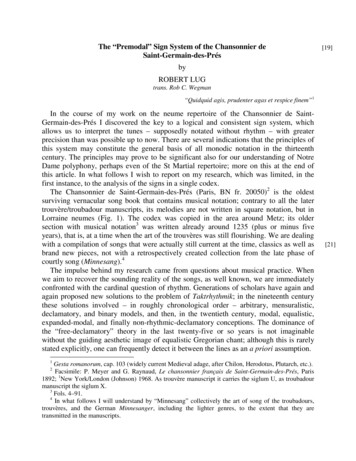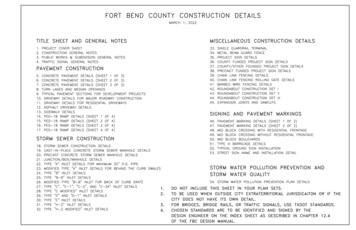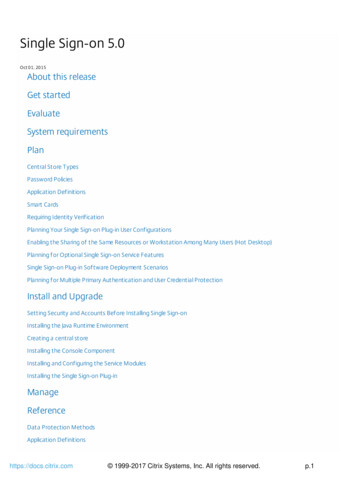
Transcription
The “Pre-Modal” Sign System of the Chansonnier Saint-Germain-des-Prés1The “Premodal” Sign System of the Chansonnier deSaint-Germain-des-Prés[19]byROBERT LUGtrans. Rob C. Wegman“Quidquid agis, prudenter agas et respice finem”1In the course of my work on the neume repertoire of the Chansonnier de SaintGermain-des-Prés I discovered the key to a logical and consistent sign system, whichallows us to interpret the tunes – supposedly notated without rhythm – with greaterprecision than was possible up to now. There are several indications that the principles ofthis system may constitute the general basis of all monodic notation in the thirteenthcentury. The principles may prove to be significant also for our understanding of NotreDame polyphony, perhaps even of the St Martial repertoire; more on this at the end ofthis article. In what follows I wish to report on my research, which was limited, in thefirst instance, to the analysis of the signs in a single codex.The Chansonnier de Saint-Germain-des-Prés (Paris, BN fr. 20050)2 is the oldestsurviving vernacular song book that contains musical notation; contrary to all the latertrouvère/troubadour manuscripts, its melodies are not written in square notation, but inLorraine neumes (Fig. 1). The codex was copied in the area around Metz; its oldersection with musical notation3 was written already around 1235 (plus or minus fiveyears), that is, at a time when the art of the trouvères was still flourishing. We are dealingwith a compilation of songs that were actually still current at the time, classics as well asbrand new pieces, not with a retrospectively created collection from the late phase ofcourtly song (Minnesang).4The impulse behind my research came from questions about musical practice. Whenwe aim to recover the sounding reality of the songs, as well known, we are immediatelyconfronted with the cardinal question of rhythm. Generations of scholars have again andagain proposed new solutions to the problem of Taktrhythmik; in the nineteenth centurythese solutions involved – in roughly chronological order – arbitrary, mensuralistic,declamatory, and binary models, and then, in the twentieth century, modal, equalistic,expanded-modal, and finally non-rhythmic-declamatory conceptions. The dominance ofthe “free-declamatory” theory in the last twenty-five or so years is not imaginablewithout the guiding aesthetic image of equalistic Gregorian chant; although this is rarelystated explicitly, one can frequently detect it between the lines as an a priori assumption.1Gesta romanorum, cap. 103 (widely current Medieval adage, after Chilon, Herodotus, Plutarch, etc.).Facsimile: P. Meyer and G. Raynaud, Le chansonnier français de Saint-Germain-des-Prés, Paris1892; 1New York/London (Johnson) 1968. As trouvère manuscript it carries the siglum U, as troubadourmanuscript the siglum X.3Fols. 4–91.4In what follows I will understand by “Minnesang” collectively the art of song of the troubadours,trouvères, and the German Minnesanger, including the lighter genres, to the extent that they aretransmitted in the manuscripts.2[21]
2Robert Lug[22]Fig. 1: Chansonnier de Saint-Germain-des-Prés, fol. 86r. [20]At present the arena of the Taktrhythmus battles is filled with exhausted arguments in amist of paralytic aporia. For that reason it would not seem an especially promisingmaneuver at the present time to launch a frontal attack on the question of rhythm. Yet aflanking maneuver may perhaps offer the prospect of a breakthrough.
The “Pre-Modal” Sign System of the Chansonnier Saint-Germain-des-Prés3Fig. 2: Troubadour chanson in four transcriptions(Peire d’Alvergne, PC 323.15; version of the manuscript R) [21]What I have in mind is a return to the question of the microrhythm (Feinrhythmik)within ligatures. In courtly song research this question has tended to be regarded as asecondary one. Sometimes it might come up in the attempt to accommodate excessivenumbers of notes in a preconceived regular rhythmic scheme, but frequently – as in thecase of the declamatory conception – it seemed possible to leave it out of considerationaltogether. Taking the reverse route, in this situation, that is, giving priority to thequestion of microrhythm, seemed to promise new insights; after its resolution it might bepossible to enter the problem area of the Taktrhythmik from a new constellation ofevidence.In the first instance I did not seek bearings in Gregorian chant research. Since wecannot take as a priori accepted that there must have been connections between thewritten liturgical repertoire, on the one hand, and song notations as documents of aprimarily oral culture, on the other, it seemed advisable to examine the area of courtlysong in isolation.Further narrowing down led me to focus on a single manuscript, whose notation couldbe explored systematically and in detail. Surprises were not to be ruled out.5*5“In the semiotics of musical notation, which would concern itself with the functional relationshipsbetween the sign systems and what they signify while taking into account the situation of the person(s) towhom they signify, virtually everything remains to be done” (L. Treitler, The Early History of MusicWriting in the West, JAMS XXXV, 1982, p. 238).
4[23]Robert LugThe old part of the Chansonnier de Saint-Germain-des-Prés contains the melodies for114 songs; a count of all the signs ( syllables provided with neumes) yields a totalnumber of 8,476 notational signs.Of these, 59 % are single notes;6 the remaining 40.55 % (3,437 signs) are ligatures oftwo or more notes, beginning with clivis and pes, up to seven-note ligatures. There are nofigures containing more than seven notes.The more complex figures are exceedingly rare: altogether we find only five sevennote and eleven six-note ligatures. Five-note ligatures, of which there are only 59, can beregarded as exceptional as well. Taken together, the five-, six-, and seven-note ligaturesmake up less than 0.9 % of the total number of signs.7 Even the four-note ligatures, as agroup, do not constitute a greater share than 2.03 %.8 The song melodies, then, consist ofsingle notes and two- and three-note ligatures for a good 97 %.These statistical data may suggest the degree to which melodic formation introubadour and trouvère songs is different from the Gregorian repertoire; a separateapproach, therefore, seems required also because of the different nature of the availablevocabulary of melodic figures.9 However, in the course of this discussion we will alsoencounter indications pointing to connections between these two repertories. Forexample, the constructive principles ruling the more complex signs, even the unica, areperfectly consistent. Besides, a detailed analysis does not yield any indication that thewriting of the exceptional figures presented any kind of difficulty to the notators; on thecontrary, the cursus of the script testifies throughout to ample experience. These factswould be inexplicable without some connection with ecclesiastical notational practice.But let us not preempt later conclusions.For those concerned with practical issues, the first question must be: do the ligaturessignify “melismas,” that is, chains of notes of approximately equal weight and equalduration – or do they signify notes of different weight, possibly “ornamented singlenotes,” in which case we would have to distinguish between structural and ornamentalnotes? A systematic analysis of the sign repertory of the Chansonnier de Saint-Germaindes-Prés makes allows us to answer this question.106Puncta: 58.78 % (4,982 signs); bipuncta: 0.07 % (6 signs); liquescent puncta and liquescent bipuncta:0.6 % (51 signs: 6 upward liquescent and 15 downward liquescent puncta; 13 upward liquescent and 17downward liquescent bipuncta).775 signs 0.88 %.8Including all those with bipuncta: 172 signs.9There are further conspicuous differences; one example may suffice: the pes occurs exclusively as afigure for stepwise progressions (with the exception of two third-leap pedes in a later addition). There isno trace of pedes involving the leap of a fourth or fifth, as is so common in plainchant.10The chain of reasoning that is reduced to its essentials here in sections I-IV can be found in a morerichly documented exposition in my work Der Chansonnier de Saint-Germain-des-Prés (Paris, BN fr.20050) – Edition seiner Melodien mit Analysen zur “vormodalen” Notation des 13. Jahrhunderts undeiner Transkriptionsgeschichte des europäischen Minnesangs, 3 vols., Frankfurt am Main (Lang), 1995,in press. Of the altogether seven deductive stages, only the four that are codex-immanent will be sketched
The “Pre-Modal” Sign System of the Chansonnier Saint-Germain-des-Prés5IA systematic classification of all the signs (Fig. 3), beginning with the punctum, andthen proceeding with two-note figures all the way up to the most complex signs, mayserve as a basis from which to proceed. For the sake of visual clarity this table employsconventional transcription in neutral notation.Fig. 3: The repertory of figures used in theChansonnier de Saint-Germain [24]here (the remaining three fall under the aspect of “traces of orality”: the tenor in Guido of Arezzo;brevis/longa and proprietas/perfectio in modal notation; recent song traditions in the British Isles).[25]
6Robert LugAltogether we find – without graphic variants – 81 different note-figures when we takeinto account intervallic differences. If we ignore intervallic differences, then the sum totalis 63.In this labyrinth a pattern seems to emerge. The list of neumes shows a notablepeculiarity with regard to the “doubled notes” (bipuncta: Fig. 4, arrow).11 Altogether 27of the 63 figures (43 %) contain these note-doublings (Bipunktierungen).Fig. 4: Bipuncta (examples) [25][26]In courtly song research, the existence of these bipuncta has tended to be commentedupon, if at all, with a certain sense of despair. None of the rhythmic theories had any usefor them; occasionally scholars would be content to explain bipuncta away as modes ofperformance. The phenomenon has not so far been subjected to systematic enquiry. Theonly point that is agreed upon is that bipuncta must in some way indicate length – butlength in relation to what? At present it is generally assumed that the bipuncta (inaccordance with the presumed “iconicity” of the notation) must be about twice as long asall other “pitches.”12 But two things are noteworthy about the bipuncta in theChansonnier:11I designate as “Bipunktierung” not only the successive occurrence of two puncta of the same pitchat the beginning of a neume, but generally the successive occurrence of two note signs of the same pitchin the course of a ligature. This includes, therefore, all cases of an “equal-pitch suffix”: punctum clivis,biclivis, clivis climacus, etc.12For Hendrik van der Werf, who is the chief representative of the free-declamatory doctrine, bipunctaare especially paradoxical; after expounding his theory of the approximately equal value of all notes, headds: “However, the medieval scribes conveyed an important bit of information by writing a few pitcheswith double notes. . From this we may conclude that some pitches were approximately, but notprecisely, twice as long as the others” (in: S. N. Rosenberg, S. Danon, eds., The Lyrics and Melodies ofGace Brulé, New York/London 1985, p. 342. Similarly van der Werf in The Extant TroubadourMelodies, Rochester 1984, p. 13). The analysis proposed here will arrive at a different conclusion; therewill an unequivocal answer also to the controversial question of repercussive or contracted performance(below, n. 34).
The “Pre-Modal” Sign System of the Chansonnier Saint-Germain-des-Prés7The Chansonnier de Saint-Germain-des-Prés contains exclusively b i p u n c t a , nevertripuncta or further repetitions.13Bipuncta may be found at the beginning of a sign, or within the course of sign, butn e v e r at the end of a sign.Why never at the end? This curious finding allows two possible inferences:1) The last note of a ligature14 is never long. Or:2) The last note of a ligature is generally long; it was not necessary to notate this,because it was a matter of “what was tacitly accepted in oral practice.”IIIt is possible to decide this issue with the help of song endings. The last notes of songstanzas, as a rule, are long. This stands to reason from everyday experience; for theMiddle Ages we may in addition point to the significance of the finalis as the goal andpoint of repose of songs – a fact which theorists described with rare unanimity. Fig. 5shows what can be observed in the Chansonnier de Saint-Germain.Fig. 5: Signs used for song endings inthe Chansonnier de Saint-Germain [27]13Multiple repetitions are frequently found in Gregorian chant and occasionally in passages sine litterain the Notre Dame repertoire.14In what follows, “ligature” will be synonymous with “Mehrtonverbinding.” A differentiationbetween ligature and conjunction is of no consequence for the syllabic figures at issue here.[27]
8Robert LugOf the 109 completely-notated songs15 in the codex, 38 end on a single note; this noteis always written as a punctum, never as a bipunctum. The remaining 71 songs have aligature on the last syllable:Twenty songs conclude with a pes, thirty with a clivis, six with a pressus.16 Ten songsconclude with descending three-note ligatures; nine of these show the normal form of theclimacus, and in one case we are dealing with a biclivis elongated in the middle. Foursongs conclude with four-note ligatures; one with a six-note figure.Consequently, given that the notators of the Chansonnier de Saint-Germain never writea bipunctum for the final note, or characterize it as long in any other way, we may drawthe following inference:[28]In those cases where the ending of a ligature is definitely long, the fact that it is longis not notated as such.The hypothesis of the long final note, as a case of “what was tacitly accepted in oralpractice,” thus receives substantial support (numerically speaking, in 71 cases).The second inference concerns the three final signs that have a bipunctum at thebeginning or in the middle (arrows in Fig. 5). Their fairly frequent occurrence (altogethereight times, that is, 11.3 % of the ligature endings) shows, on the one hand, that weshould not understand the endings as melismas that arrive at the final point of repose byslowing down ad libitum; rather, relative note durations are carefully indicated even onthe last syllable: pressus is distinguished from clivis, climacus from biclivis, and in thecase of the descending four-note series, the normal from from the one whose second notehas been lengthened (brackets in Fig. 5).On the other hand, the final signs that involve bipuncta give a particularly strongindication regarding the length of the final note: immediately before the final, within thesame ligature, long values are indicated by means of bipuncta – which would havecreated a paradoxical effect if the final note were to have been short, as the notationindicates in appearance only.The principle of construction of the notators is brought into focus in the concludingfigures: One can read from one and the same sign that long values have to benotated when they occur at the beginning or in the middle, but never when theyoccur at the end. Evidently it was somehow “known into” the ligature.IIIIn order to rule out that this conclusion might be valid only for the special case of songendings, we must now examine ligatures at any other point in the melody. For this wemay employ the method of comparing melodic parallels. The principle is shown in Fig. 6.15There are five songs of which only the beginnings have been notated.The term stands for “doubled-note clivis.” I prefer the designation “pressus,” since it brings this verycharacteristic sign in the vicinity of the pes, clivis, climacus, etc., where it functionally belongs. In thethirteenth century there is no danger of terminological confusion with regard to the pressus.16
The “Pre-Modal” Sign System of the Chansonnier Saint-Germain-des-Prés9Repetitions of melody parts within one and the same song are found especially inStollen repetitions but also at various other points. Notators have never shown a particularconcern to “normalize” such repetitions, and as a result one can observe numerousvariants. For the question at issue here, the variants that are significant above all are thosewhere single notes are found in the place of ligatures, or the other way round. When thesingle note corresponds to the final note of the ligature (as in Fig. 6, asterisk), then thiswould confirm the hypothesis of a general and self-evident melodic center at the end; ifthe parallels follows no apparent pattern, then this would speak against that hypothesis.Fig. 6: Variants in Stollen repetitions (in neutral transcription)17 [29]To throw light on this question I have examined all comparable passages in the 114songs. Here are the results:181) Pes/Punctum:11 passages support the final-note hypothesis,2 (exceptional cases) speak against it17Chansonnier de Saint-Germain, fol. 10r (Gace Brulé, RS 1102).In what follows I have presented only the multiply occurring variants, and have omitted singlyoccurring cases. For this, see C II 5 of my edition (showing all variants, inclusing shifts of passages, etc.).18[29]
10Robert Lug2) Clivis/Punctum:[30]For: 22 passages. Against: 4 passages.193) Climacus/Punctum:For: 3 passages. Against: none.The preponderance of passages that confirm the hypothesis is significant; the number ofexceptions remains within the range of variation that might have been expected.20 Offurther interest are the following results of the comparison of variants:4) Climacus/Clivis:For: 2 passages. Against: none.5) Pressus/Clivis:[31]11 times, each time on the same note location.6) Biclivis/Climacus:214 times, every time on the same note location.19See the following note.Variants like, for example, Punctum c/Punctum b, are encountered quite frequently. – Regarding thefour deviations in the clivis/punctum variant: the clivis has a particular “tendency to variation” because itaims toward the (low) structural note from the position of the high note. Every practical attempt showsthat a short high note before the structural note (clivis) stands out “more prominently,” or receives greateremphasis than a brief low note (pes). In the four passages in question we find the additional specialcircumstance that we are dealing with liquescent neumes throughout; the complete clivis sign hererepresents the less frequent liquescent form. It is not just this commonality, but especially the ratio 4 : 22,which shows that these are exceptions from the rule – the rule being the dominance of the final note.21The ligated-abbreviated form of the biclivis (in the system, below Fig. 11, sign no. 5.1; cf. note 38)is not identified as a special sign in conventional neutral transcriptions; either it is treated like theclimacus (three note-heads) or like the written-out biclivis (four note-heads). To distinguish these for thetime being, while using neutral transcription, I have used void note-heads in the abbreviated passages(thus also in Figs. 3 and 4).20
The “Pre-Modal” Sign System of the Chansonnier Saint-Germain-des-Prés11The two bipunctum variant groups 5) and 6) provide an especially strong indication infavor of the long value of the endnote. Ought one not assume (in the case of the pressusand biclivis) that the additional weight on the bipunctum would have caused variants toplace weight precisely on the penultimate and not on the final note?22 Instead of this wefind the “fundamental sign” variant throughout (that is, clivis or climacus), whose weightrests on the final note, as can be shown in systematic fashion.So the final note – or so we may conclude from this – carries the chief weight also inthe pressus and biclivis.23 This is not, to be sure, apparent from the graphic appearance; itis only the known long value of the final note that allows a correct interpretation (moreon this below, IV c). The result of our third step, then, is as follows:The tacitly understand long value of the final note, in oral practice, is confirmed asthe general principle of ligature construction in the Chansonnier de Saint-Germain.Detailed comparison of individual figures yields further conclusions:The chief note (or structural note) at the end of the ligature is a “long,” the notespreceding it are “shorts,” or ornamental notes, unless they are turned into bipunctaand thereby also characterized as chief notes.Contrary to graphic appearance, the use of bipuncta does not provide greaterweight to the note in question than the implicit weight given to final notes. Bothindicate – the final weight as a tacit oral assumption, the bipunctum as a graphicway of highlighting – the structural notes of ligatures. Signs with bipuncta thuscontain at least two or (if there are two bipuncta in one ligature) three structuralnotes.The final notes of ligatures have the same rank as single notes (syllable-carrying,unornamented notes).NB: “longs” and “shorts” are not to be understood in terms of a proportionally fixedrelationships. What it means is rather a difference in functional emphasis, which may beexpressed in note duration, accentuation, or both – a continuum of uses that the notationseeks to convey with a flexibility that does justice to musical practice yet is neverthelessstill quite precise.As a matter of fact, it does seem that we are dealing with a fundamental law of oralsong. Guido of Arezzo already describes a tenor (extension of note duration) on the finalnotes of every syllaba.24 With regard to the early notation of sacred music, the disciplineof “Gregorian Semiology” has been working slowly and carefully on the significance ofthe final note, which tends to be understood, under the key term of “syllable articulation,”22For example, for pressus ccb punctum c, biclivis cbba clivis cb.Apparent confirmation: the double variant in Song No. 95 (fol. 51r), line/syllable 2.3/8.3/10.5:pressus ggf / clivis gf / punctum f.24Micrologus, Chapter 15. Discussed at length in Part C II 2 of my edition.23[32]
12[33]Robert Lugas the melodic goal of the ornamented progression.25 Here we are dealing, just as in thecase of secular song, with a principle of emphasis accommodating speech, in whichsyllables would naturally be reinforced at the end and would thus feature a slightslowing-down or emphasis that led towards the next syllable: “Flo-o-o – re-e-et si-i-il –va .,” “O du schöner We-e-es-terwald.” Due to changes in musical writing this principleis no longer self-evident today.IVThe results obtained so far by comparative means receive impressive confirmationfrom the comprehensive systematicity of the signs.The suspicion that there might be a hidden principle of organisation or construction atwork in the sign labyrinth of the Chansonnier de Saint-Germain-des-Prés took onincreasingly firm shape during the analyses. What was notable above all was the graphicassuredness of the notators; combined signs, often quite rare figures, were constructedwith evident consistency, and appeared with identical construction in locations that werefar apart. Yet there was not as yet a plausible explanation as to the principle according towhich the elements were put together in so consistent a fashion. The written tradition ofthe entire song corpus could not have provided a prior foundation: all troubadour/trouvèremanuscripts yield the unanimous conclusion that these were compiled fromheterogeneous sources.Did there then perhaps exist a generally practiced “musical orthography” for thenotation of orally transmitted or newly created song tunes? One prior considerationseemed to argue in favor of that possibility: around 1200 the quantity of “new music” inNorthern France grew on an unprecedented scale; this repertoire was in part dependent onnotation (composed polyphony) and in part considered worthy of notation (monophonicconducti and others). Applied in the first instance to the art of educated clerics, thisnotation-worthiness soon comprised the secular art of song of the nobility (trouvères,troubadours), which achieved classic status around the same time and was frequentlyconnected with the sacred musical art.This massive new task was bound to prompt a change in the function and quality ofmusical writing: up to then it had served chiefly for the copying26 of the liturgicalrepertory that had been transmitted and canonized in written form (writing writing), butthe new challenge now was the notation of “new” music (ear writing). At the same timeit seems that the number of scribal workshops and notational specialists multiplied. Given25Cf. the contributions of R. Fischer, Die rhythmische Natur des Pes (pp. 34–77), J. B. Göschl, Zumrhythmischen und ästhetischen Problem der Silbenartikulation bei aufsteigenden Neumen (pp. 179–221),N. Albarosa, Aspetti dell’articolazione sillabica sui neumi discendenti (pp. 222–37), in: FestschriftEugène Cardine, St. Ottilien 1980, as well as the publications of the three authors in: Beiträge zurGregorianik I (1985), pp. 43–102, II (1986), pp. 5–25, and III (1986), pp. 52–72. But the chant specialistsstill distance themselves from the understanding of song figures in the sense of performativeornamentation as it is manifested in recent traditions.26Including transcriptions and redactions.
The “Pre-Modal” Sign System of the Chansonnier Saint-Germain-des-Prés13these prior considerations, it stood to reason that musicians would have endeavored todevelop, as much as possible, a practicable (uncomplicated), general, and easilydistributed system of signs.The key to this hypothetical systematicity was not easily found, however. In pursuing [34]that key, several possible classifications of the neume corpus presented themselves, froma simple listing according to sign lengths (see Fig. 3), via groupings according to graphicelements, to the outlines of unified “genealogies.”1) Impossibility of a system of suffixes.Let us first sketch one attempt whose results seemed to come close to the actual state ofaffairs yet in the end proved fruitless; this may serve to establish immediately that it isnot possible to find a consistent system of organisation if one projects the wrongprinciple. The endeavor was to find a system of organisation in which the notationalfigures would be characterised in terms of the beginning of the ligature.27 Byprogressively appending more and more elements at the end of the sign – following, inother words, the principle of the suffix – it should then be possible to obtain coherentpatterns of ramification branching out all the way to the complex signs (Figs. 7 and 8).Fig. 7: Basic ramification pattern28 of an attempted “suffix system” [34]27The characterisation of signs in terms of their endings seemed up to then as (tacitly) self-evident andis mirrored, for example, in Gregorian terminology: the designations “climacus resupinus” (), “pessubpunctis” (), etc., betray an interpretation of the larger signs as “basic neume plus suffix.”28For the sake of visual clarity I have not constructed here the entire scheme with its furtherramifications. Fig. 8 shows the examples of scandicus (a), porrectus (b), and the biclivis (c); theconnection points are framed by boxes in Fig. 7.
14Robert LugFig. 8: Inconsistencies in a system of suffixes:suffix branches of the scandicus, porrectus, and biclivis [36]
The “Pre-Modal” Sign System of the Chansonnier Saint-Germain-des-Prés15Although there appeared logical connections in places, there were fundamental flawsthat seemed hard to dismiss. The principle of ramification, which was generally binary innature (upward/downward), was persistently violated by the bipuncta signs. It becamenecessary to posit hypothetical intermediate links featuring a double final note ( inFigs. 7 and 8).29 Several branches consisted predominantly of “missing links”: signs thatare theoretically possible in terms of their construction but nevertheless remain unattested(marked with square brackets [ ] in Fig. 8). This was especially jarring in the ramificationpattern of the biclivis (Fig. 8c).Signs that evidently belong together graphically appeared randomly scattered acrossseveral different branches – notable especially with the signs that have the conspicuoustorculus element; see the various different positions in Figs. 8a and 8b (furtherincidental occurrences can be found in the branches not shown here).30[35]2) The Sign Tree according to the final-note principleIt was only the growing realization of the central importance of the final note that ledto the idea to approach the system of signs the other way round: from the ending, byattaching before it successive prefixes. The result is shown in Fig. 9.All the figures arrange themselves into the outline of a Sign Tree. Proceeding from thepunctum, the single note sign, we position in each case a note before it. This prefix notemay be on a higher pitch, the same pitch, or lower pitch; at every point, therefore, thereare three possible branches.31Prefixes with equal pitch lead to bipuncta; their existence follows directly from thelogic of the ternary ramification system.32 One observes the economy with which notatorsuse this logic to fashion the double notes with the indication “structural note” (length).All branches are perfectly consistent until the fifth generation, without the need toposit connecting links that were left out in practice; only at the end do we encounter fourlarge figures whose genealogically prior signs are not attested in the chansonnier (dottedlines). The notational precision extends even to details: the graphic micro-elements, as arule, are used for the construction of larger figures, and the characteristic endings of thesigns remain graphically consistent; this can be demonstrated by the example
richly documented exposition in my work Der Chansonnier de Saint-Germain-des-Prés (Paris, BN fr. 20050) – Edition seiner Melodien mit Analysen zur “vormodalen” Notation des 13. Jahrhunderts und einer Transkriptionsgeschichte des europäischen Minnesangs, 3 vols., F










